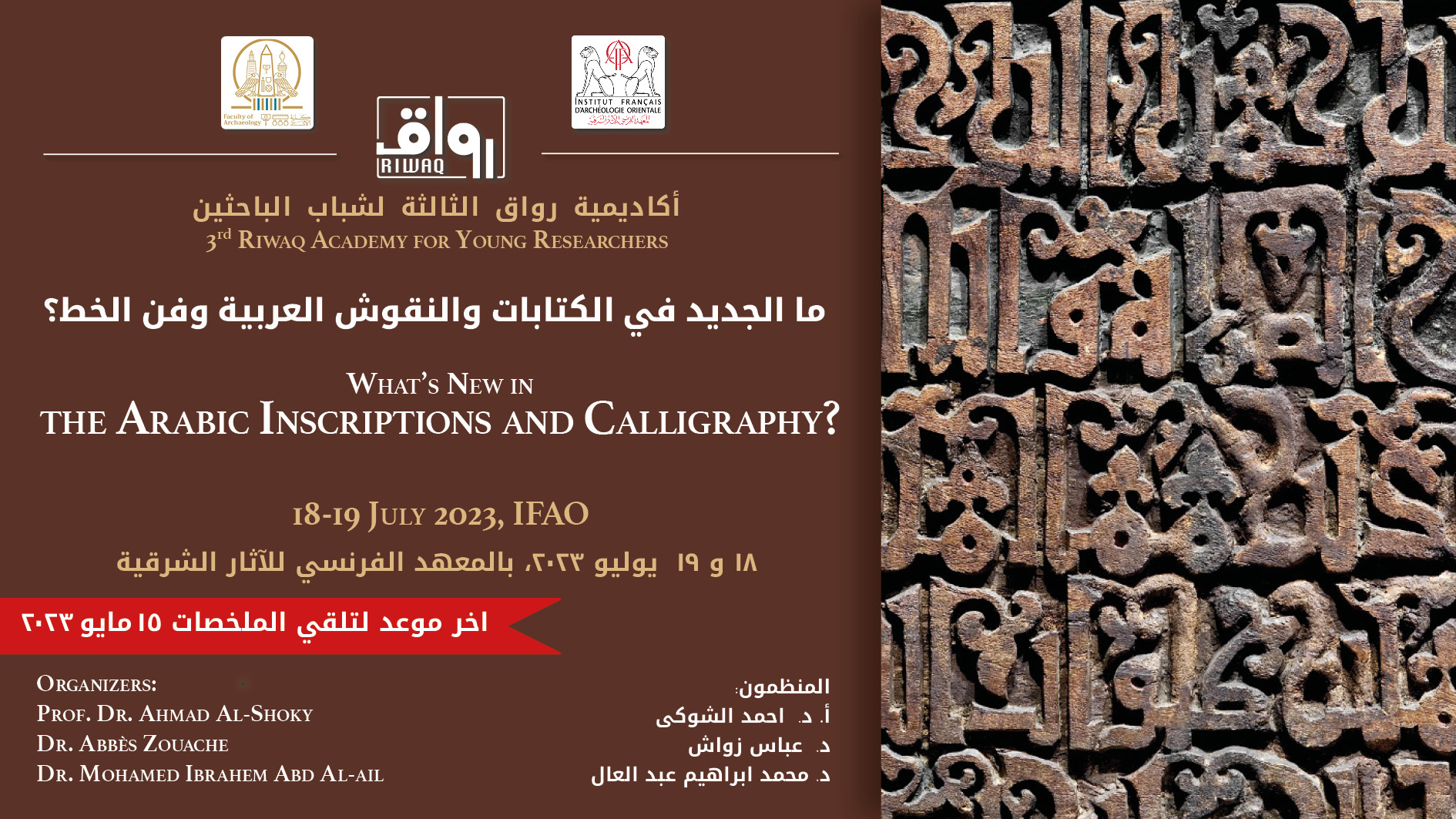Manifestations scientifiques
Abonnez-vous à la … Subscribe to the Mailing list :

Formation
Du mardi 18 juillet 2023 au mercredi 19 juillet 2023 à 10h00 (heure du Caire), IFAO 
3rd Riwaq Academy for Young Researchers: What’s new in the Arabic inscriptions and calligraphy?
أكاديمية « رواق » الثالثة لشباب الباحثين : ما الجديد في الكتابات والنقوش العربية وفن الخط؟
Partenaire(s) de l’Ifao : Faculty of Archeology, Ain Shams university
Langue : arabe.
أكاديمية « رواق » الثالثة لشباب الباحثين - ٢٠٢٣
ينظمها المعهد الفرنسي للآثار الشرقية بالتعاون مع كلية الآثار–جامعة عين شمس
تحت عنوان: ما الجديد في الكتابات والنقوش العربية وفن الخط؟
في الفترة من ١٨و ١٩ يوليو ٢٠٢٣
يتواجد الخط العربي على الآثار كشاهد على تاريخ الحضارة العربية الإسلامية، ويؤكد المؤرخون أن الخط العربي ارتقى بارتقاء الحضارة الإسلامية، وبعد أن كان الخط بلا قاعدة وضعت له القواعد والأصول، والأحبار، والألوان، وعدّلوا من كيفية إمساك الكاتب للقلم.
يعتبر الخط العربي جوهر الفنون الإسلامية التي أسهمت بنصيب وافر في تشكيل هذه الحضارة الإنسانية، بل هو من أبرز العناصر التي استعملها الفنان المسلم؛ بحيث لا تكاد تجد عملًا فنيًا إسلاميًا لا يكون للخط مكانته البارزة فيه، ومن ثم صار الخط العربي من أبرز الدلائل المميزة للفن الإسلامي كما أضحى دليلًا يسيرًا للتعرف على هوية التحف والعمائر. وتعرّف النقوش الكتابية الإسلامية أنها تلك النصوص المنقوشة على العمائر بأنواعها والتحف الفنية الأخرى وشواهد القبور، والمسكوكات والمنسوجات، وهي كتابات تتصف بطابعها الأثري حيث تتميز هذه النقوش بالتنوع في مضمونها ما بين تأسيسية تؤرخ لإنشاء وتجديد العمائر، أو نقوش دعائية وإعلامية أو وقفيات أو مراسيم أو شواهد قبور وأيضًا نقوش دينية (آيات قرآنية أو أحاديث وأدعية)، كما تتنوع من الناحية الأدبية أيضًا إلى كتابات نثرية أو أبيات شعرية. ولهذا الأمر يعقد هذا الملتقى العلمي في موسمه الثالث من أجل إلقاء الضوء على أحدث الدراسات في مجال الكتابات والنقوش وفنون الخط في العصور الإسلامية والمختلفة.
محاور الملتقى العلمي:
- الدراسات الحديثة في فنون الكتابات الإسلامية والنقوش على مر العصور.
- التكنولوجيا والرقمنة الحديثة وكيفية استخدامها في مجال الكتابات والنقوش الإسلامية.
- النقوش الزخرفية المنفذة على آثار العالم الإسلامي.
- أنواع الخطوط المستخدمة في الزخارف على الفنون المختلفة.
- الكتابات والزخارف على الفنون الإسلامية.
- النقوش الكتابية على المنشآت الدينية والمدنية بالعالم الإسلامي.
- شواهد القبور وأشكالها والنقوش المنفذة عليها على مر العصور.
تحميل البرنامج المبدئي للملتقى
لحضور جلسات الأكاديمية يرجى ملىء استمارة التسجيل
رئيسا اكاديمية رواق:
أ.د/ أحمد الشوكي د/ عباس زيواش
المشرف على التنظيم
د/ محمد ابراهيم عبد العال
اللجنة التنظيمية:
د/ نوال جابر
د/ أشجان أحمد
د/ محمود أحمد
د/ رشا المفتش
عمرو بهجت
إيمان علي سليم
The Third Riwaq Academy for Young Researchers
Organized by The French Institute for Oriental Archaeology (IFAO) in cooperation with the Faculty of Archeology, Ain Shams University
What’s New in Arabic Writings, Inscriptions and Calligraphy?
(18-19 July 2023)
Monumental Arabic calligraphy bears witness to the history of Arabo-Islamic civilization. Historians confirm that Arabic calligraphy developed in lockstep with the development of Islamic civilization. Calligraphy, whichhad not yet been standardized, was endowed with rules, principles, colors, and ink; even how the scribe held the pen was reformed.
Arabic calligraphy is considered the heart of Islamic art, which itself contributed abundantly to the formation of this human civilization. Calligraphy is also one of the most prominent elements deployed by Muslim artists, and one can scarcely find an Islamic artwork in which calligraphy does not occupy a prominent place. Thus, Arabic calligraphy became one of the most prominent identifying markers of Islamic art, demonstrating the identity of artworks and buildings. Islamic inscriptions consist of texts inscribed on buildings of various kinds, artworks, grave markers, coins, and textiles. These writings are identified by their historical-material character and distinguished by the diversity of their content: foundation inscriptions that date the erection or restoration of buildings, propagandistic inscriptions, endowment inscriptions, decrees, grave markers, and religious inscriptions (Qur’anic verses, hadiths, and supplications). In literary terms, inscriptions also vary between prose texts and verses of poetry. The third annual session of this scientific forum is convoked around this subject. The forum aims to bring to light the latest studies in the field of writings, inscriptions, and the calligraphic arts in Islamic and other eras.
Themes of the Scientific Forum
- Recent studies on Islamic written arts and inscriptions across periods.
- Modern technologies, digitization, and possibilities for their use in the domain of Islamic writings and inscriptions.
- Inscriptions used to decorate monuments in the Islamic world.
- Types of calligraphic scripts used for decoration in various arts.
- Writing and decoration in Islamic art.
- Inscriptions on religious and civic structures in the Islamic world.
- Grave markers, their forms, and the inscriptions used on them across periods.
DOWNLOAD PROVISIONAL PROGRAMME
The Academy’s Organization Members
Riwaq Academy Presidents:
Prof. Dr. Ahmad Al-Shoky - Dr. Abbès Zouache
Organization supervisor
Dr. Mohamed Ibrahim Abd el-Ail
Organizing Committee:
Dr. Nawal Jaber
Dr. Ashgan Ahmed
Dr. Mahmoud Ahmed
Dr. Rasha El-Mofatch
Amr Bahgat
Eman Ali


